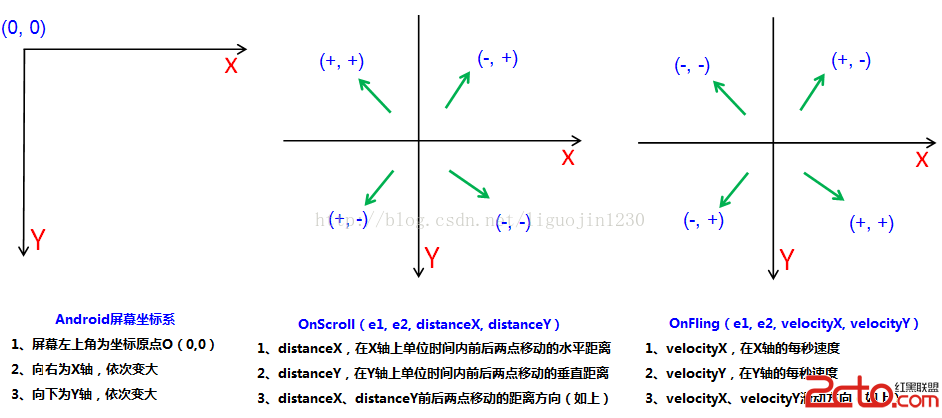編輯:關於Android編程
前面兩篇博文講解的都是Android 的2D動畫效果,要想做出非常炫酷的3D動畫效果怎麼辦?android 並沒有提供3D動畫接口給用戶,所以我們得自己重寫這樣一個3D接口動畫。
接口如下:
/*
* @Title: My3dAnimation.java
* @Description: TODO<請描述此文件是做什麼的>
* @author: xjp
* @data: 2014年9月15日 上午8:54:10
* @version: V1.0
*/
package com.xjp.animator;
import android.graphics.Camera;
import android.graphics.Matrix;
import android.view.animation.Animation;
import android.view.animation.Transformation;
/**
* TODO<請描述這個類是干什麼的>
*
* @author xjp
* @data: 2014年9月15日 上午8:54:10
* @version: V1.0
*/
public class My3dAnimation extends Animation {
private final float mFromDegrees;
private final float mToDegrees;
private final float mCenterX;
private final float mCenterY;
private final float mDepthZ;
private Camera mCamera;
private int mDirection;
private final static int ROTATE_X = 0;//沿著x軸旋轉
private final static int ROTATE_Y = 1;//沿著y軸旋轉
/**
* Creates a new 3D rotation on the Y axis. The rotation is defined by its
* start angle and its end angle. Both angles are in degrees. The rotation
* is performed around a center point on the 2D space, definied by a pair of
* X and Y coordinates, called centerX and centerY. When the animation
* starts, a translation on the Z axis (depth) is performed. The length of
* the translation can be specified, as well as whether the translation
* should be reversed in time.
*
* @param direction
* the direction of the 3D rotation
* @param fromDegrees
* the start angle of the 3D rotation
* @param toDegrees
* the end angle of the 3D rotation
* @param centerX
* the X center of the 3D rotation
* @param centerY
* the Y center of the 3D rotation
*/
public My3dAnimation(int direction, float fromDegrees, float toDegrees,
float centerX, float centerY, float depthZ) {
mDirection = direction;
mFromDegrees = fromDegrees;
mToDegrees = toDegrees;
mCenterX = centerX;
mCenterY = centerY;
mDepthZ = depthZ;
}
@Override
public void initialize(int width, int height, int parentWidth,
int parentHeight) {
super.initialize(width, height, parentWidth, parentHeight);
mCamera = new Camera();
}
@Override
protected void applyTransformation(float interpolatedTime, Transformation t) {
final float fromDegrees = mFromDegrees;
float degrees = fromDegrees
+ ((mToDegrees - fromDegrees) * interpolatedTime);
final float centerX = mCenterX;
final float centerY = mCenterY;
final Camera camera = mCamera;
final Matrix matrix = t.getMatrix();
camera.save();
if (centerX!=0){
if (interpolatedTime < 0.5) {
camera.translate(0.0f, 0.0f, mDepthZ * interpolatedTime);
} else {
camera.translate(0.0f, 0.0f, mDepthZ * (1.0f - interpolatedTime));
}
}
switch (mDirection) {
case ROTATE_X:
camera.rotateX(degrees);
break;
case ROTATE_Y:
camera.rotateY(degrees);
break;
}
camera.getMatrix(matrix);
camera.restore();
matrix.preTranslate(-centerX, -centerY);
matrix.postTranslate(centerX, centerY);
}
}
示例代碼如下:
package com.xjp.animator;
import com.xjp.animator.R;
import android.os.Bundle;
import android.view.View;
import android.view.ViewGroup;
import android.view.animation.LinearInterpolator;
import android.widget.ImageView;
import android.app.Activity;
public class MainActivity extends Activity implements
android.view.View.OnClickListener {
private ImageView img1;
private ImageView img2;
private ImageView img3;
private ViewGroup mContainer;
private final static int ROTATE_X = 0;
private final static int ROTATE_Y = 1;
private My3dAnimation my3dAnimation;
@Override
protected void onCreate(Bundle savedInstanceState) {
super.onCreate(savedInstanceState);
setContentView(R.layout.activity_main);
findViews();
}
/**
* TODO<請描述這個方法是干什麼的>
*
* @throw
* @return void
* @param
*/
private void findViews() {
// TODO Auto-generated method stub
mContainer = (ViewGroup) findViewById(R.id.container);
mContainer
.setPersistentDrawingCache(ViewGroup.PERSISTENT_ANIMATION_CACHE);
img1 = (ImageView) findViewById(R.id.img_left);
img1.setOnClickListener(this);
img2 = (ImageView) findViewById(R.id.img_right);
img2.setOnClickListener(this);
img3 = (ImageView) findViewById(R.id.img_3);
img3.setOnClickListener(this);
}
@Override
public void onClick(View v) {
// TODO Auto-generated method stub
float centerX = v.getWidth() / 2.0f;
float centerY = v.getHeight() / 2.0f;
if (v.getId() == R.id.img_left) {
my3dAnimation = new My3dAnimation(ROTATE_X, 0, 180, centerX,
centerY, 310f);
}
if (v.getId() == R.id.img_right) {
my3dAnimation = new My3dAnimation(ROTATE_Y, 0, 180, centerX,
centerY, 310f);
}
if (v.getId() == R.id.img_3) {
centerX = 0;
my3dAnimation = new My3dAnimation(ROTATE_Y, 0, 20, centerX,
centerY, 310f);
}
my3dAnimation.setDuration(1000);
my3dAnimation.setInterpolator(new LinearInterpolator());
my3dAnimation.setFillAfter(true);
v.startAnimation(my3dAnimation);
}
}
 進階四之Android UI介面之(Gallery仿圖像集浏覽)
進階四之Android UI介面之(Gallery仿圖像集浏覽)
兩個人共嘗一個痛苦只有半個痛苦,兩個人共享一個歡樂卻有兩個歡樂。 本講內容:Gallery仿圖像集浏覽 一、基本原理 在 Activity 中實現 OnGest
 Android開發 ----------如何真機調試?
Android開發 ----------如何真機調試?
一般來說 真機調試 是最快的, 所以建議 大家 直接用真機調試。
 Android開發中CheckBox的簡單用法示例
Android開發中CheckBox的簡單用法示例
本文實例講述了Android開發中CheckBox的簡單用法。分享給大家供大家參考,具體如下:CheckBox是一種在界面開發中比較常見的控件,Android中UI開發也
 android高仿小米時鐘(使用Camera和Matrix實現3D效果)
android高仿小米時鐘(使用Camera和Matrix實現3D效果)
繼續練習自定義View。。畢竟熟才能生巧。一直覺得小米的時鐘很精美,那這次就搞它~這次除了練習自定義View,還涉及到使用Camera和Matrix實現3D效果。一個這樣